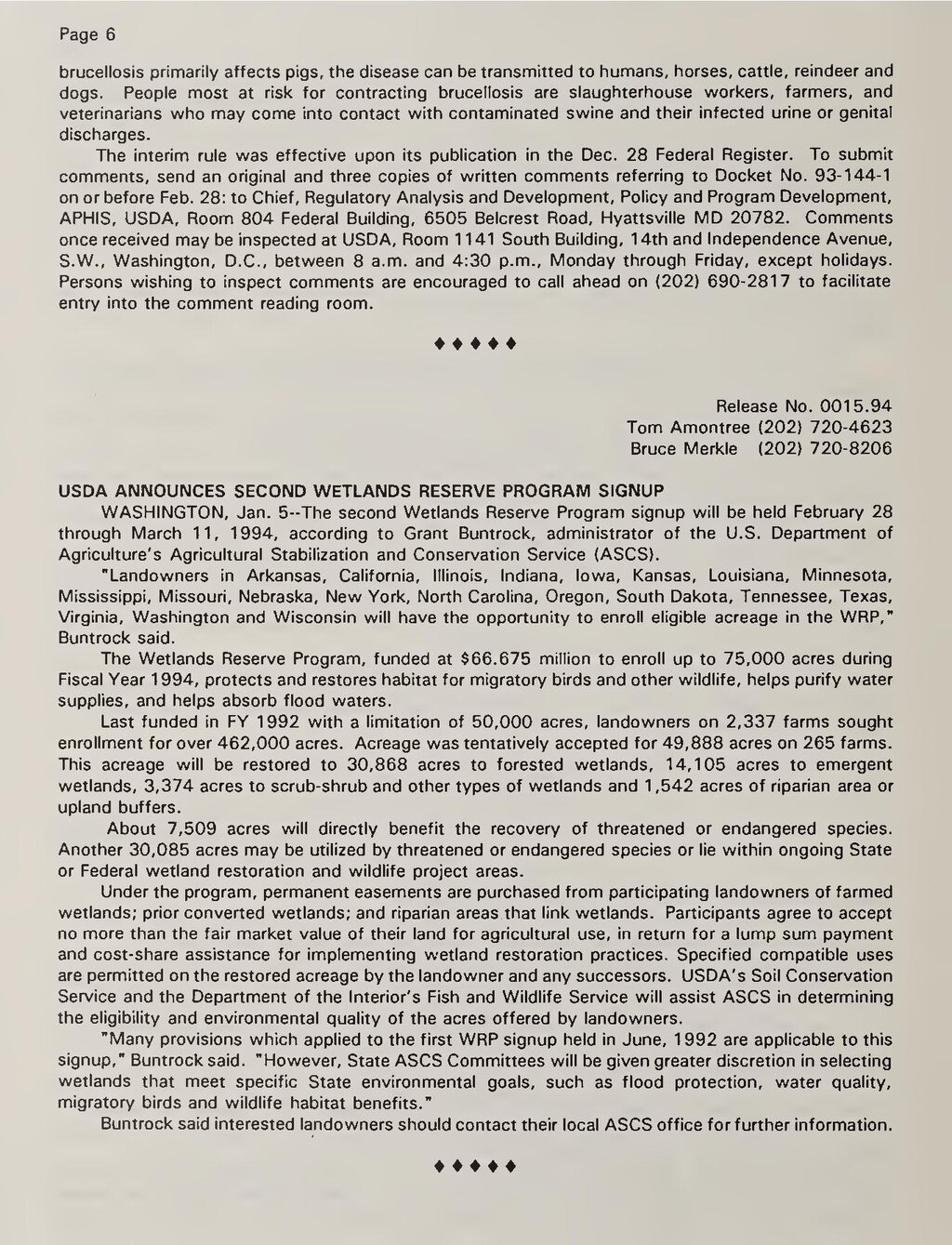brucellosis primarily affects pigs, the disease can be transmitted to humans, horses, cattle, reindeer and dogs. People most at risk for contracting brucellosis are slaughterhouse workers, farmers, and veterinarians who may come into contact with contaminated swine and their infected urine or genital discharges.
The interim rule was effective upon its publication in the Dec. 28 Federal Register. To submit comments, send an original and three copies of written comments referring to Docket No. 93-144-1 on or before Feb. 28: to Chief, Regulatory Analysis and Development, Policy and Program Development, APHIS, USDA, Room 804 Federal Building, 6505 Belcrest Road, Hyattsville MD 20782. Comments once received may be inspected at USDA, Room 1141 South Building, 14th and Independence Avenue, S.W., Washington, D.C., between 8 a.m. and 4:30 p.m., Monday through Friday, except holidays. Persons wishing to inspect comments are encouraged to call ahead on (202) 690-2817 to facilitate entry into the comment reading room.
♦ ♦ ♦ ♦ ♦
Release No. 0015.94
Tom Amontree (202) 720-4623
Bruce Merkle (202) 720-8206
USDA ANNOUNCES SECOND WETLANDS RESERVE PROGRAM SIGNUP
WASHINGTON, Jan. 5--The second Wetlands Reserve Program signup will be held February 28 through March 11, 1994, according to Grant Buntrock, administrator of the U.S. Department of Agriculture's Agricultural Stabilization and Conservation Service (ASCS).
"Landowners in Arkansas, California, Illinois, Indiana, Iowa, Kansas, Louisiana, Minnesota, Mississippi, Missouri, Nebraska, New York, North Carolina, Oregon, South Dakota, Tennessee, Texas, Virginia, Washington and Wisconsin will have the opportunity to enroll eligible acreage in the WRP," Buntrock said.
The Wetlands Reserve Program, funded at $66.675 million to enroll up to 75,000 acres during Fiscal Year 1994, protects and restores habitat for migratory birds and other wildlife, helps purify water supplies, and helps absorb flood waters.
Last funded in FY 1992 with a limitation of 50,000 acres, landowners on 2,337 farms sought enrollment for over 462,000 acres. Acreage was tentatively accepted for 49,888 acres on 265 farms. This acreage will be restored to 30,868 acres to forested wetlands, 14,105 acres to emergent wetlands, 3,374 acres to scrub-shrub and other types of wetlands and 1,542 acres of riparian area or upland buffers.
About 7,509 acres will directly benefit the recovery of threatened or endangered species. Another 30,085 acres may be utilized by threatened or endangered species or lie within ongoing State or Federal wetland restoration and wildlife project areas.
Under the program, permanent easements are purchased from participating landowners of farmed wetlands; prior converted wetlands; and riparian areas that link wetlands. Participants agree to accept no more than the fair market value of their land for agricultural use, in return for a lump sum payment and cost-share assistance for implementing wetland restoration practices. Specified compatible uses are permitted on the restored acreage by the landowner and any successors. USDA's Soil Conservation Service and the Department of the Interior's Fish and Wildlife Service will assist ASCS in determining the eligibility and environmental quality of the acres offered by landowners.
"Many provisions which applied to the first WRP signup held in June, 1992 are applicable to this signup," Buntrock said. "However, State ASCS Committees will be given greater discretion in selecting wetlands that meet specific State environmental goals, such as flood protection, water quality, migratory birds and wildlife habitat benefits."
Buntrock said interested landowners should contact their local ASCS office for further information.
♦ ♦ ♦ ♦ ♦
